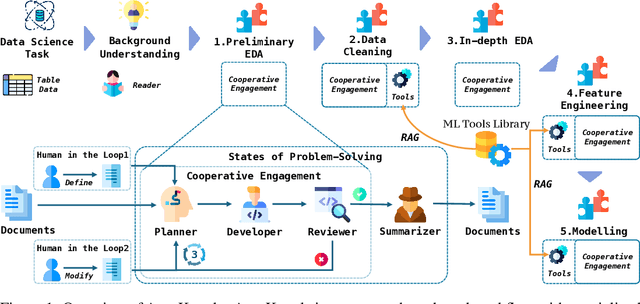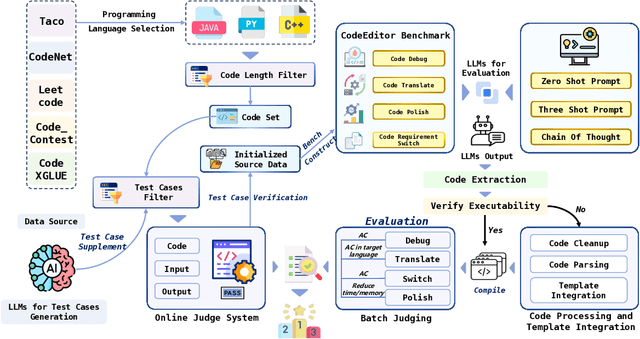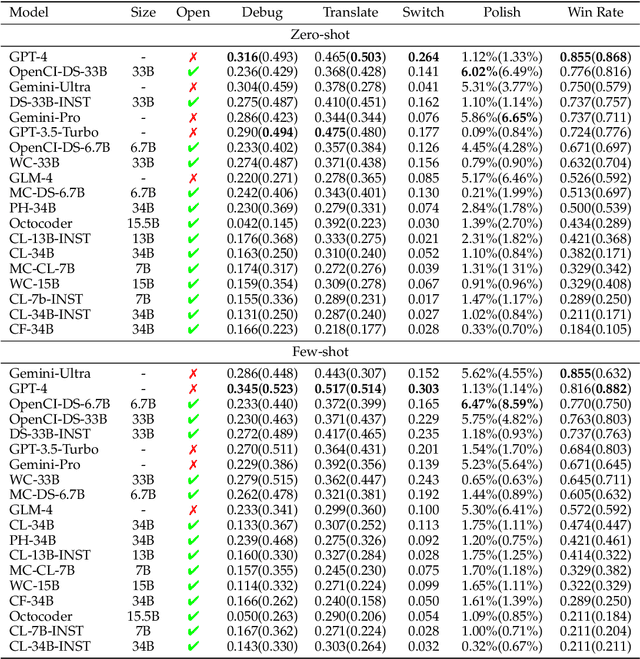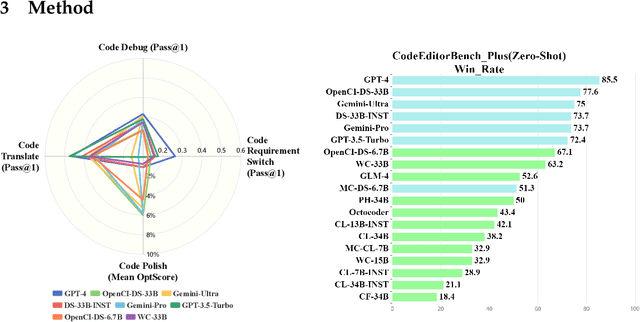Jiawei Guo
AutoKaggle: A Multi-Agent Framework for Autonomous Data Science Competitions
Oct 29, 2024



Abstract:Data science tasks involving tabular data present complex challenges that require sophisticated problem-solving approaches. We propose AutoKaggle, a powerful and user-centric framework that assists data scientists in completing daily data pipelines through a collaborative multi-agent system. AutoKaggle implements an iterative development process that combines code execution, debugging, and comprehensive unit testing to ensure code correctness and logic consistency. The framework offers highly customizable workflows, allowing users to intervene at each phase, thus integrating automated intelligence with human expertise. Our universal data science toolkit, comprising validated functions for data cleaning, feature engineering, and modeling, forms the foundation of this solution, enhancing productivity by streamlining common tasks. We selected 8 Kaggle competitions to simulate data processing workflows in real-world application scenarios. Evaluation results demonstrate that AutoKaggle achieves a validation submission rate of 0.85 and a comprehensive score of 0.82 in typical data science pipelines, fully proving its effectiveness and practicality in handling complex data science tasks.
I-SHEEP: Self-Alignment of LLM from Scratch through an Iterative Self-Enhancement Paradigm
Aug 15, 2024



Abstract:Large Language Models (LLMs) have achieved significant advancements, however, the common learning paradigm treats LLMs as passive information repositories, neglecting their potential for active learning and alignment. Some approaches train LLMs using their own generated synthetic data, exploring the possibility of active alignment. However, there is still a huge gap between these one-time alignment methods and the continuous automatic alignment of humans. In this paper, we introduce \textbf{I-SHEEP}, an \textbf{I}terative \textbf{S}elf-En\textbf{H}anc\textbf{E}m\textbf{E}nt \textbf{P}aradigm.This human-like paradigm enables LLMs to \textbf{continuously self-align from scratch with nothing}. Compared to the one-time alignment method Dromedary \cite{sun2023principledriven}, which refers to the first iteration in this paper, I-SHEEP can significantly enhance capacities on both Qwen and Llama models. I-SHEEP achieves a maximum relative improvement of 78.2\% in the Alpaca Eval, 24.0\% in the MT Bench, and an absolute increase of 8.88\% in the IFEval accuracy over subsequent iterations in Qwen-1.5 72B model. Additionally, I-SHEEP surpasses the base model in various standard benchmark generation tasks, achieving an average improvement of 24.77\% in code generation tasks, 12.04\% in TrivialQA, and 20.29\% in SQuAD. We also provide new insights based on the experiment results. Our codes, datasets, and models are available at \textbf{https://anonymous.4open.science/r/I-SHEEP}.
Diffusion Transformer Captures Spatial-Temporal Dependencies: A Theory for Gaussian Process Data
Jul 23, 2024Abstract:Diffusion Transformer, the backbone of Sora for video generation, successfully scales the capacity of diffusion models, pioneering new avenues for high-fidelity sequential data generation. Unlike static data such as images, sequential data consists of consecutive data frames indexed by time, exhibiting rich spatial and temporal dependencies. These dependencies represent the underlying dynamic model and are critical to validate the generated data. In this paper, we make the first theoretical step towards bridging diffusion transformers for capturing spatial-temporal dependencies. Specifically, we establish score approximation and distribution estimation guarantees of diffusion transformers for learning Gaussian process data with covariance functions of various decay patterns. We highlight how the spatial-temporal dependencies are captured and affect learning efficiency. Our study proposes a novel transformer approximation theory, where the transformer acts to unroll an algorithm. We support our theoretical results by numerical experiments, providing strong evidence that spatial-temporal dependencies are captured within attention layers, aligning with our approximation theory.
Enhancing Neural Radiance Fields with Depth and Normal Completion Priors from Sparse Views
Jul 08, 2024


Abstract:Neural Radiance Fields (NeRF) are an advanced technology that creates highly realistic images by learning about scenes through a neural network model. However, NeRF often encounters issues when there are not enough images to work with, leading to problems in accurately rendering views. The main issue is that NeRF lacks sufficient structural details to guide the rendering process accurately. To address this, we proposed a Depth and Normal Dense Completion Priors for NeRF (CP\_NeRF) framework. This framework enhances view rendering by adding depth and normal dense completion priors to the NeRF optimization process. Before optimizing NeRF, we obtain sparse depth maps using the Structure from Motion (SfM) technique used to get camera poses. Based on the sparse depth maps and a normal estimator, we generate sparse normal maps for training a normal completion prior with precise standard deviations. During optimization, we apply depth and normal completion priors to transform sparse data into dense depth and normal maps with their standard deviations. We use these dense maps to guide ray sampling, assist distance sampling and construct a normal loss function for better training accuracy. To improve the rendering of NeRF's normal outputs, we incorporate an optical centre position embedder that helps synthesize more accurate normals through volume rendering. Additionally, we employ a normal patch matching technique to choose accurate rendered normal maps, ensuring more precise supervision for the model. Our method is superior to leading techniques in rendering detailed indoor scenes, even with limited input views.
CodeEditorBench: Evaluating Code Editing Capability of Large Language Models
Apr 06, 2024



Abstract:Large Language Models (LLMs) for code are rapidly evolving, with code editing emerging as a critical capability. We introduce CodeEditorBench, an evaluation framework designed to rigorously assess the performance of LLMs in code editing tasks, including debugging, translating, polishing, and requirement switching. Unlike existing benchmarks focusing solely on code generation, CodeEditorBench emphasizes real-world scenarios and practical aspects of software development. We curate diverse coding challenges and scenarios from five sources, covering various programming languages, complexity levels, and editing tasks. Evaluation of 19 LLMs reveals that closed-source models (particularly Gemini-Ultra and GPT-4), outperform open-source models in CodeEditorBench, highlighting differences in model performance based on problem types and prompt sensitivities. CodeEditorBench aims to catalyze advancements in LLMs by providing a robust platform for assessing code editing capabilities. We will release all prompts and datasets to enable the community to expand the dataset and benchmark emerging LLMs. By introducing CodeEditorBench, we contribute to the advancement of LLMs in code editing and provide a valuable resource for researchers and practitioners.
ACE : Off-Policy Actor-Critic with Causality-Aware Entropy Regularization
Feb 22, 2024Abstract:The varying significance of distinct primitive behaviors during the policy learning process has been overlooked by prior model-free RL algorithms. Leveraging this insight, we explore the causal relationship between different action dimensions and rewards to evaluate the significance of various primitive behaviors during training. We introduce a causality-aware entropy term that effectively identifies and prioritizes actions with high potential impacts for efficient exploration. Furthermore, to prevent excessive focus on specific primitive behaviors, we analyze the gradient dormancy phenomenon and introduce a dormancy-guided reset mechanism to further enhance the efficacy of our method. Our proposed algorithm, ACE: Off-policy Actor-critic with Causality-aware Entropy regularization, demonstrates a substantial performance advantage across 29 diverse continuous control tasks spanning 7 domains compared to model-free RL baselines, which underscores the effectiveness, versatility, and efficient sample efficiency of our approach. Benchmark results and videos are available at https://ace-rl.github.io/.
Read to Play (R2-Play): Decision Transformer with Multimodal Game Instruction
Feb 08, 2024Abstract:Developing a generalist agent is a longstanding objective in artificial intelligence. Previous efforts utilizing extensive offline datasets from various tasks demonstrate remarkable performance in multitasking scenarios within Reinforcement Learning. However, these works encounter challenges in extending their capabilities to new tasks. Recent approaches integrate textual guidance or visual trajectory into decision networks to provide task-specific contextual cues, representing a promising direction. However, it is observed that relying solely on textual guidance or visual trajectory is insufficient for accurately conveying the contextual information of tasks. This paper explores enhanced forms of task guidance for agents, enabling them to comprehend gameplay instructions, thereby facilitating a "read-to-play" capability. Drawing inspiration from the success of multimodal instruction tuning in visual tasks, we treat the visual-based RL task as a long-horizon vision task and construct a set of multimodal game instructions to incorporate instruction tuning into a decision transformer. Experimental results demonstrate that incorporating multimodal game instructions significantly enhances the decision transformer's multitasking and generalization capabilities.
Kun: Answer Polishment for Chinese Self-Alignment with Instruction Back-Translation
Jan 12, 2024Abstract:In this paper, we introduce Kun, a novel approach for creating high-quality instruction-tuning datasets for large language models (LLMs) without relying on manual annotations. Adapting a self-training algorithm based on instruction back-translation and answer polishment, Kun leverages unlabelled data from diverse sources such as Wudao, Wanjuan, and SkyPile to generate a substantial dataset of over a million Chinese instructional data points. This approach significantly deviates from traditional methods by using a self-curation process to refine and select the most effective instruction-output pairs. Our experiments with the 6B-parameter Yi model across various benchmarks demonstrate Kun's robustness and scalability. Our method's core contributions lie in its algorithmic advancement, which enhances data retention and clarity, and its innovative data generation approach that substantially reduces the reliance on costly and time-consuming manual annotations. This methodology presents a scalable and efficient solution for improving the instruction-following capabilities of LLMs, with significant implications for their application across diverse fields. The code and dataset can be found at https://github.com/Zheng0428/COIG-Kun
A deep learning framework for multi-scale models based on physics-informed neural networks
Aug 13, 2023Abstract:Physics-informed neural networks (PINN) combine deep neural networks with the solution of partial differential equations (PDEs), creating a new and promising research area for numerically solving PDEs. Faced with a class of multi-scale problems that include loss terms of different orders of magnitude in the loss function, it is challenging for standard PINN methods to obtain an available prediction. In this paper, we propose a new framework for solving multi-scale problems by reconstructing the loss function. The framework is based on the standard PINN method, and it modifies the loss function of the standard PINN method by applying different numbers of power operations to the loss terms of different magnitudes, so that the individual loss terms composing the loss function have approximately the same order of magnitude among themselves. In addition, we give a grouping regularization strategy, and this strategy can deal well with the problem which varies significantly in different subdomains. The proposed method enables loss terms with different magnitudes to be optimized simultaneously, and it advances the application of PINN for multi-scale problems.
 Add to Chrome
Add to Chrome Add to Firefox
Add to Firefox Add to Edge
Add to Edge